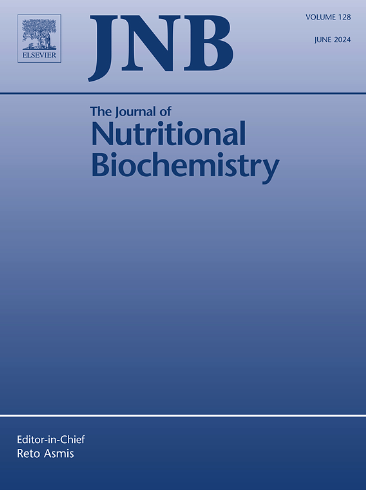内脏脂肪代谢的变化,而不是皮下脂肪组织库,减弱了喂食高脂肪饮食的肥胖抵抗小鼠的代谢紊乱。
IF 4.9
2区 医学
Q1 BIOCHEMISTRY & MOLECULAR BIOLOGY
引用次数: 0
摘要
肥胖的特征是由于热量过量引起的白色脂肪组织增大。尽管高热量饮食,但对肥胖有抵抗力的个体中白色脂肪组织的储存库特异性适应对于理解肥胖和相关代谢紊乱的发病机制至关重要。我们的目的是表征肥胖抵抗的代谢和形态学状态,并研究高脂肪饮食(60 kcal%脂肪)C57BL/6J雄性小鼠附睾内脏(eVAT)和腹股沟皮下(iSAT)白色脂肪组织中信号通路的储存库特异性变化。14周后,这些小鼠被归类为肥胖(与对照组相比,体重至少高出30%)或肥胖抵抗(体重增加低于30%)。研究了eVAT和iSAT的生化和形态学参数、组织学以及脂质代谢、炎症和胰岛素敏感性的信号通路。结果显示,尽管热量摄入增加,但抗肥胖小鼠的身体、总VAT和iSAT质量没有改变。与肥胖小鼠相比,这些动物的瘦素水平和葡萄糖稳态得到了改善。在肥胖抵抗小鼠的eVAT和iSAT中,脂肪细胞大小和脂肪分解能力保持在控制水平,而与肥胖小鼠相比,只有eVAT中保留了脂肪生成能力,改善了局部胰岛素敏感性,并且没有炎症。综上所述,与iSAT相比,eVAT的代谢适应可能对维持肥胖抵抗表型具有实质性影响,且代谢并发症较少,这可能有助于改进现有的肥胖治疗方法。本文章由计算机程序翻译,如有差异,请以英文原文为准。

Changes in lipid metabolism in the visceral rather than the subcutaneous adipose tissue depot attenuate metabolic disturbances in obesity-resistant mice fed a high-fat diet
Obesity is characterized by an enlargement of white adipose tissue caused by caloric excess. The depot-specific adaptation of white adipose tissue in individuals resistant to obesity despite a high-calorie diet is crucial for understanding the pathogenesis of obesity and related metabolic disorders. Our aim was to characterize the metabolic and morphological state of obesity resistance and to investigate depot-specific changes in signaling pathways in epididymal visceral (eVAT) and inguinal subcutaneous (iSAT) white adipose tissue of C57BL/6J male mice on a high-fat diet (60 kcal% fats). After 14 weeks, the mice were categorized as obese (at least 30% higher body mass compared to the control group) or obesity-resistant (weight gain below 30%). Biochemical and morphological parameters, as well as histology, and signaling pathways involved in lipid metabolism, inflammation, and insulin sensitivity were investigated in eVAT and iSAT. The results showed unaltered body, total VAT and iSAT mass in obesity-resistant mice despite increased caloric intake. Leptin levels and glucose homeostasis were improved in these animals compared to the obese mice. In both eVAT and iSAT of the obesity-resistant mice, adipocyte size and lipolytic capacity were retained at control levels, while compared to the obese mice, preserved capacity for adipogenesis, improved local insulin sensitivity and the absence of inflammation were observed only in the eVAT. In conclusion, metabolic adaptation of eVAT rather than iSAT may have a substantial impact on the maintenance of the obesity-resistant phenotype with fewer metabolic complications, which could contribute to the improvement of existing obesity therapies.
求助全文
通过发布文献求助,成功后即可免费获取论文全文。
去求助
来源期刊

Journal of Nutritional Biochemistry
医学-生化与分子生物学
CiteScore
9.50
自引率
3.60%
发文量
237
审稿时长
68 days
期刊介绍:
Devoted to advancements in nutritional sciences, The Journal of Nutritional Biochemistry presents experimental nutrition research as it relates to: biochemistry, molecular biology, toxicology, or physiology.
Rigorous reviews by an international editorial board of distinguished scientists ensure publication of the most current and key research being conducted in nutrition at the cellular, animal and human level. In addition to its monthly features of critical reviews and research articles, The Journal of Nutritional Biochemistry also periodically publishes emerging issues, experimental methods, and other types of articles.
 求助内容:
求助内容: 应助结果提醒方式:
应助结果提醒方式:


